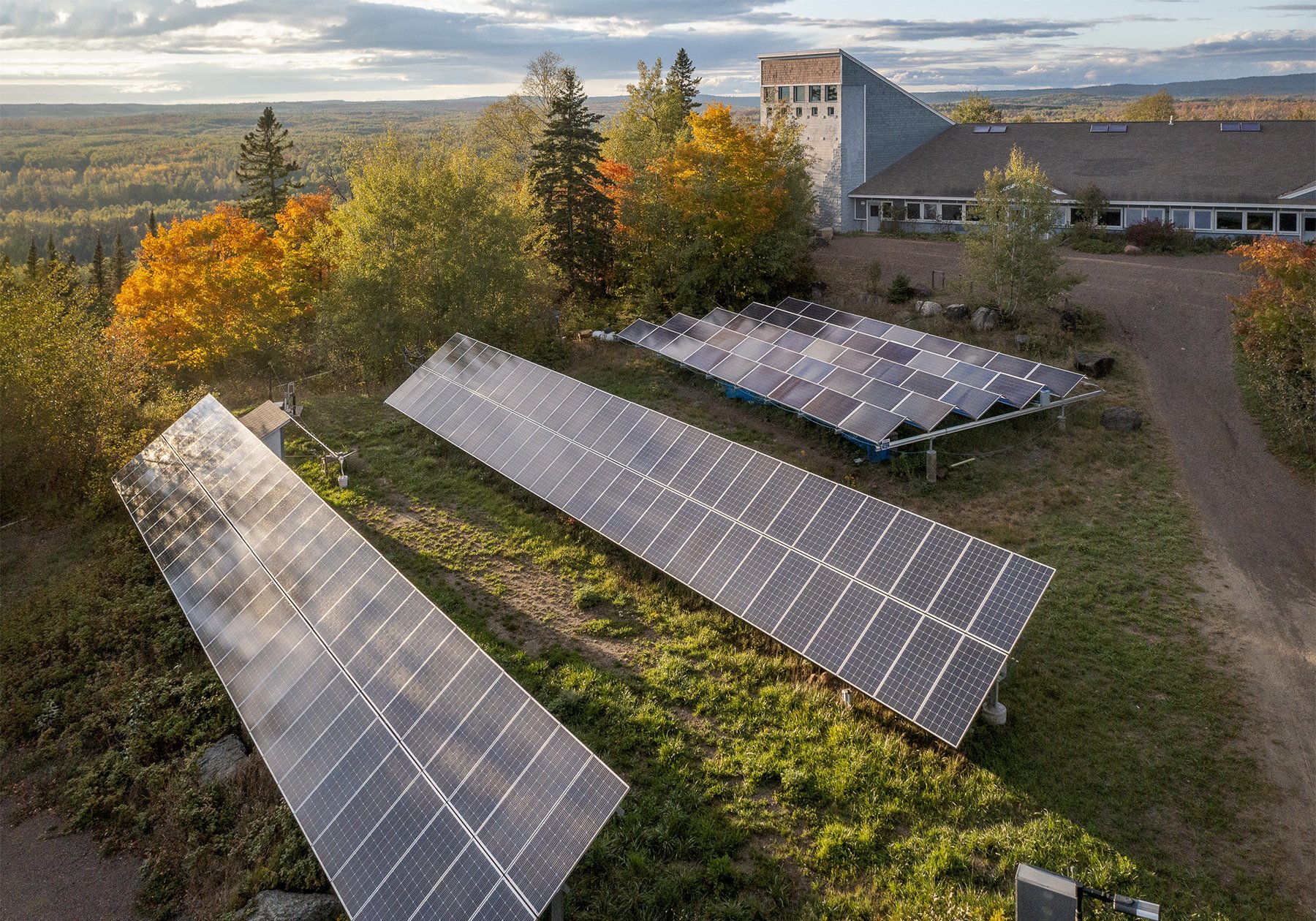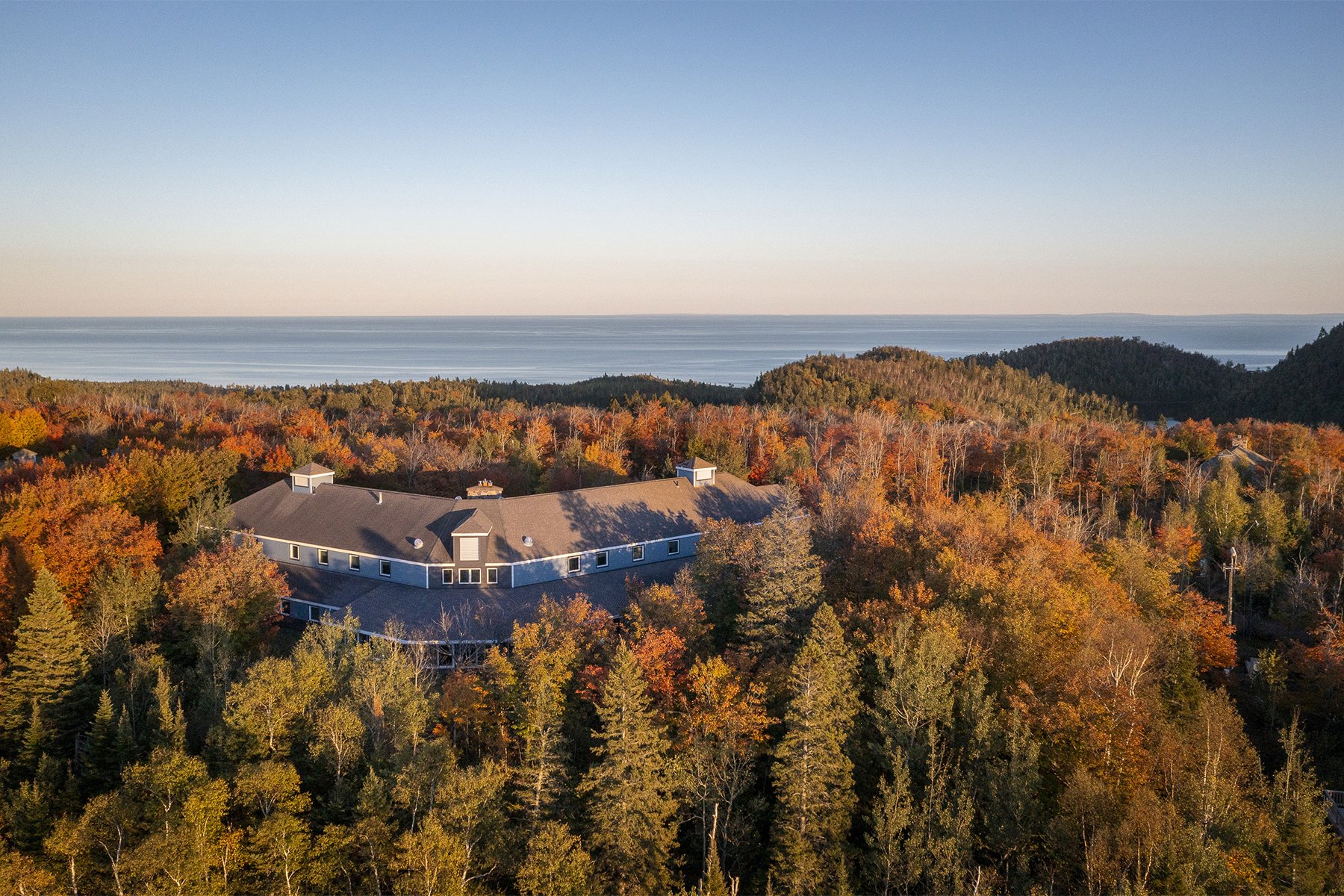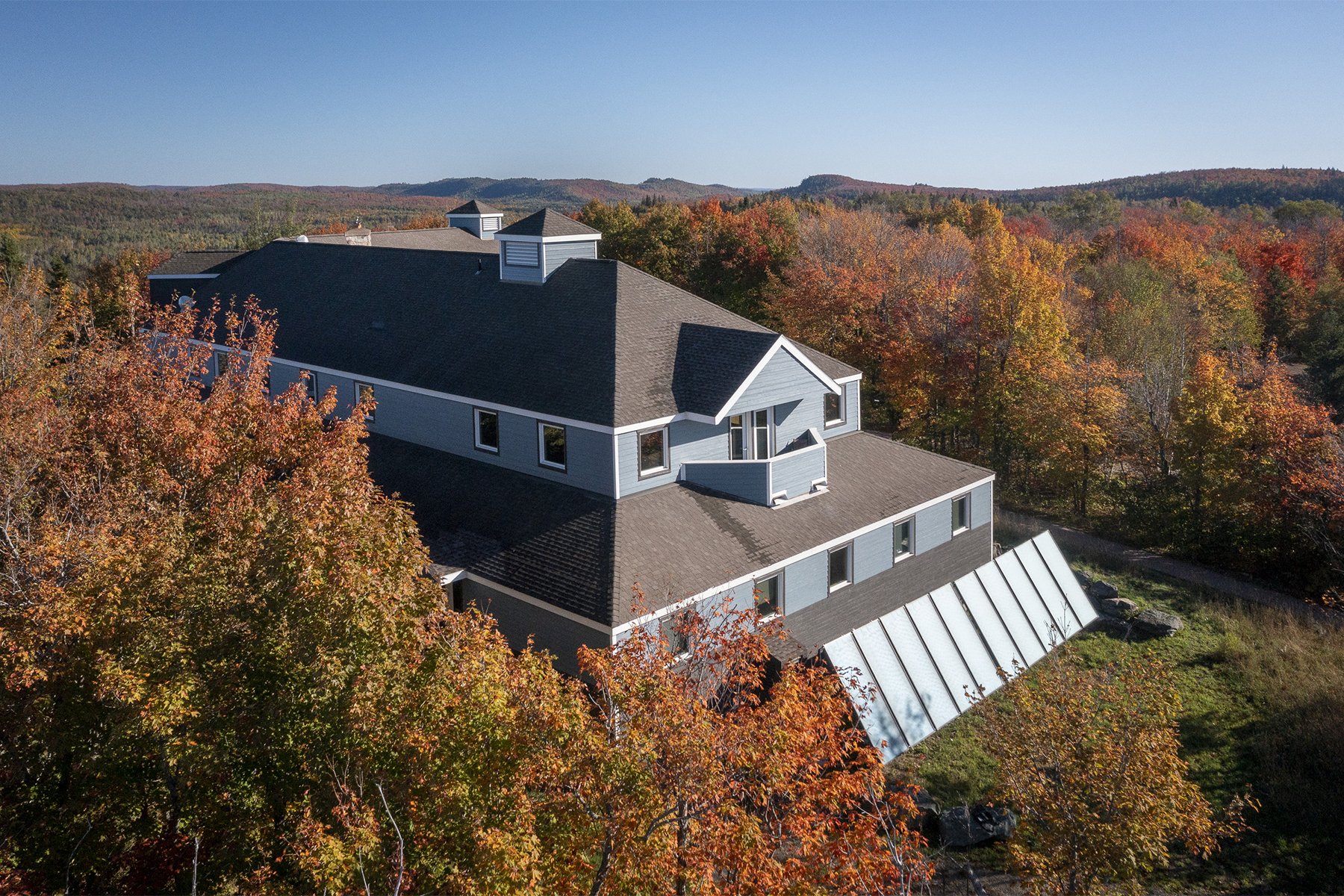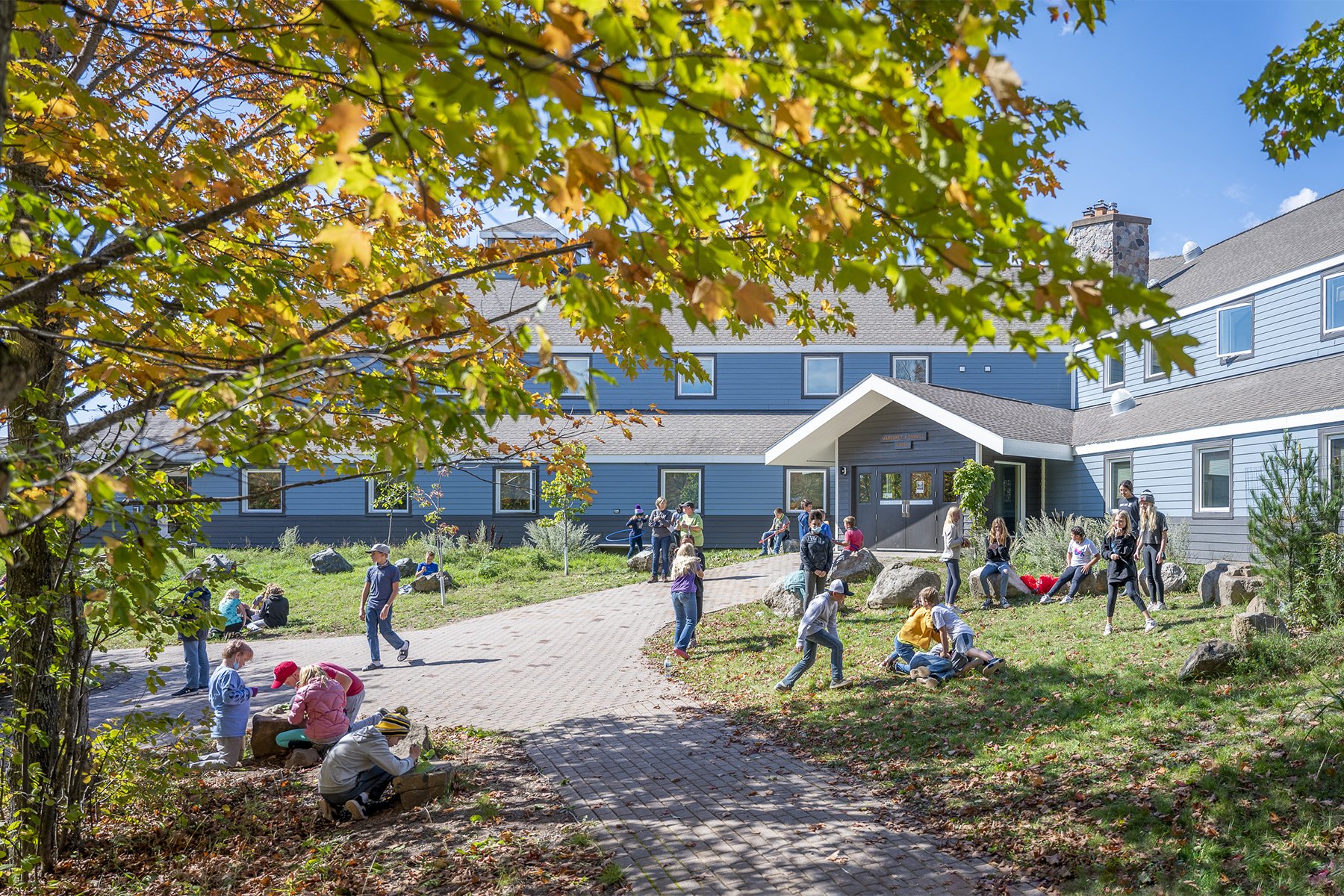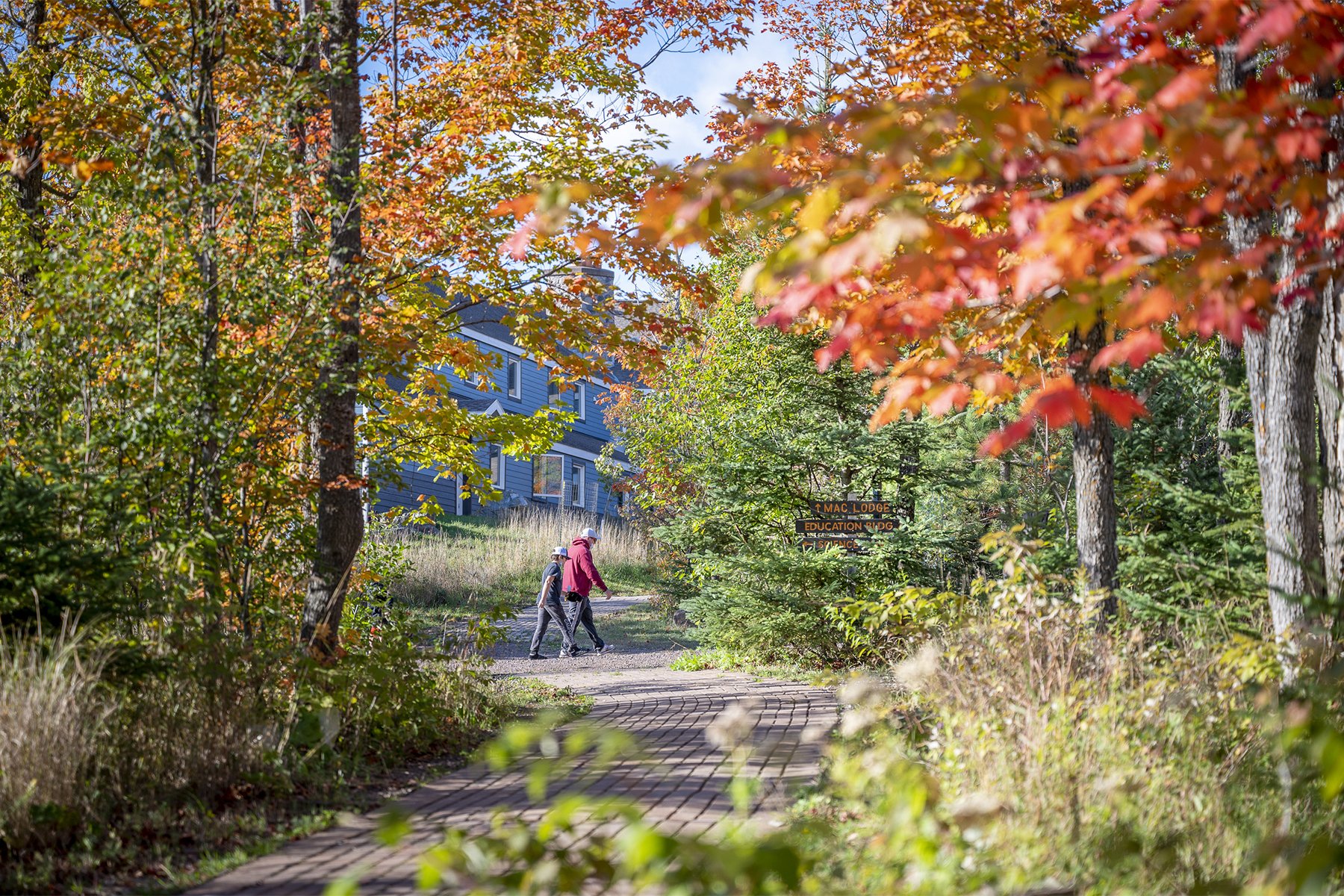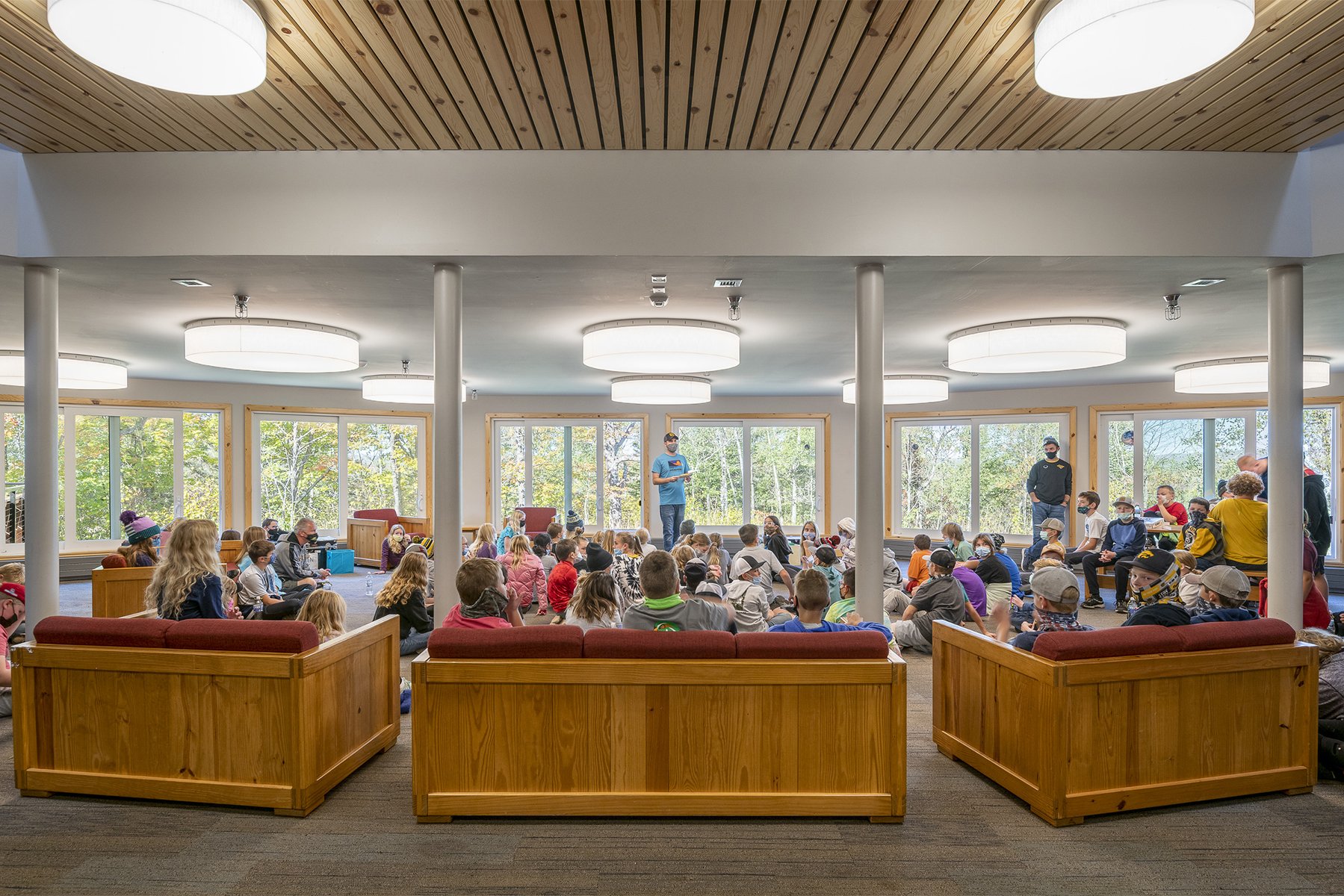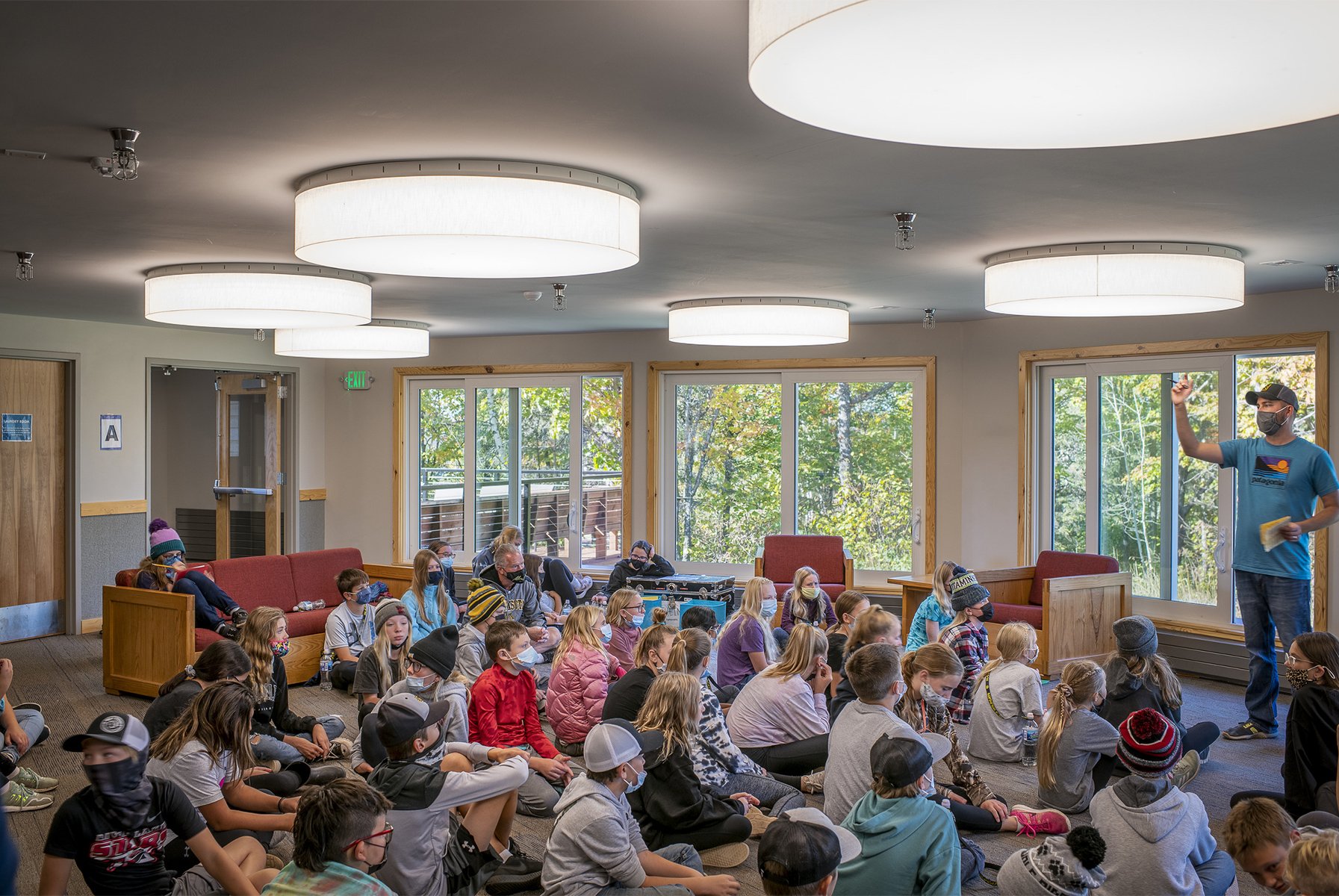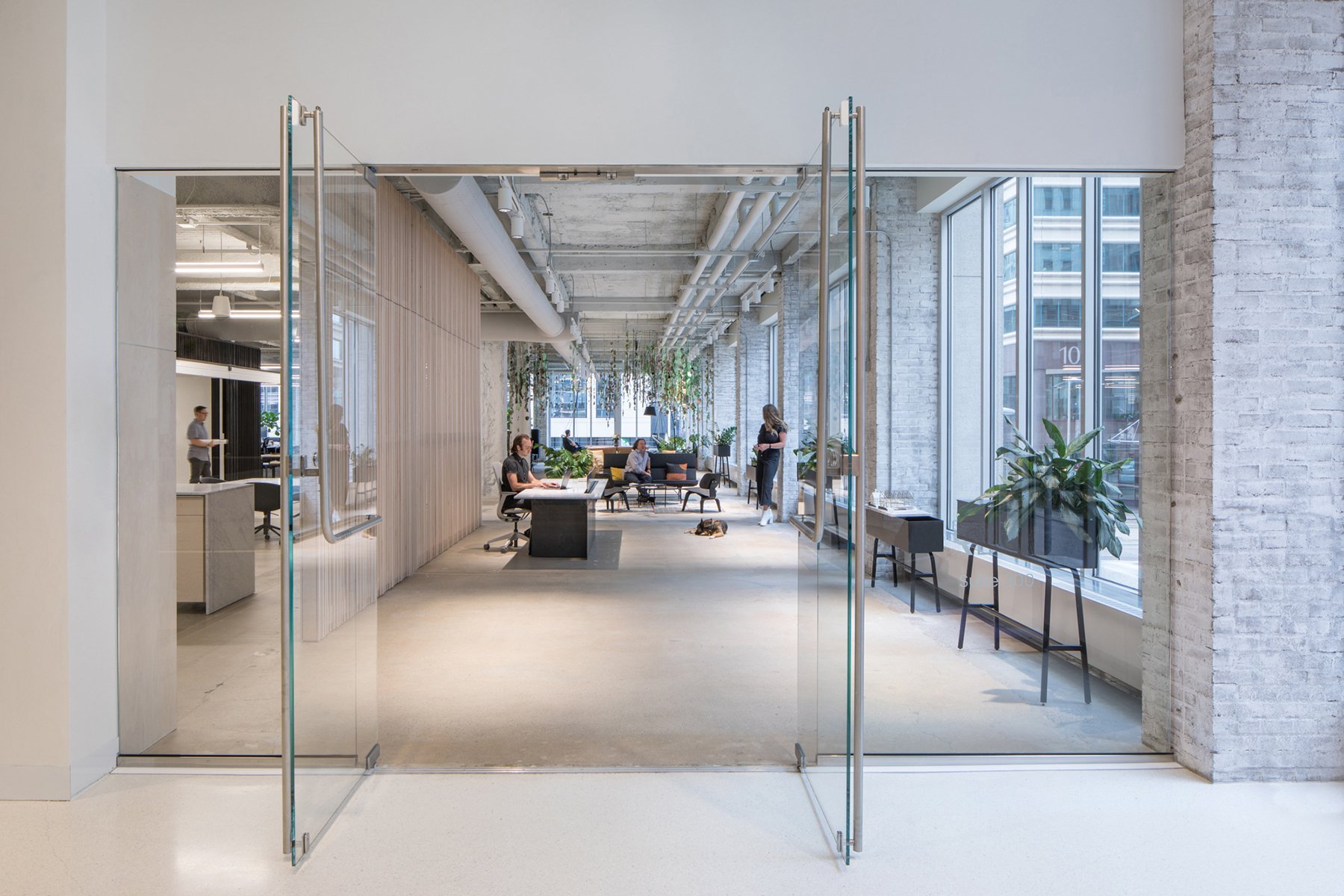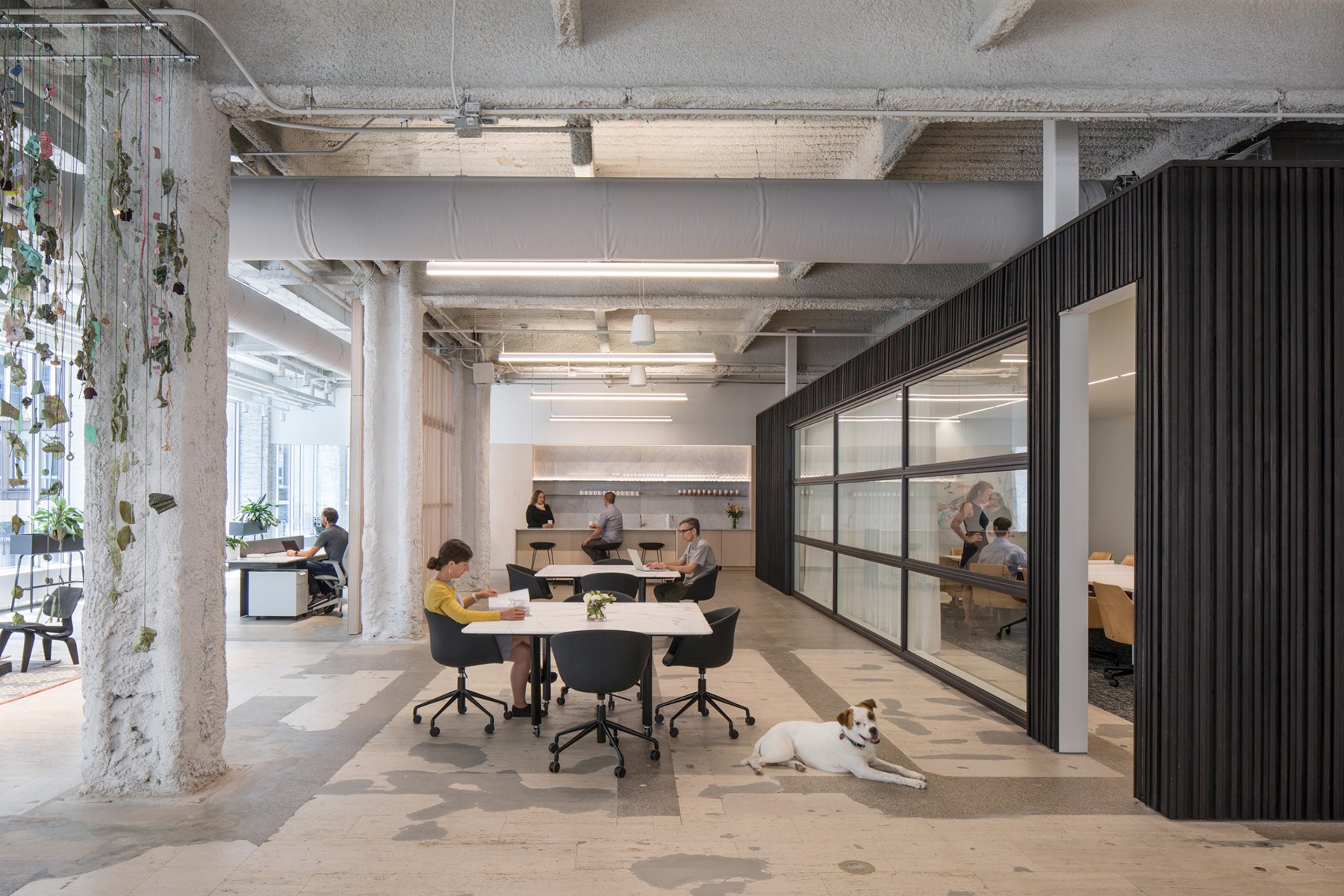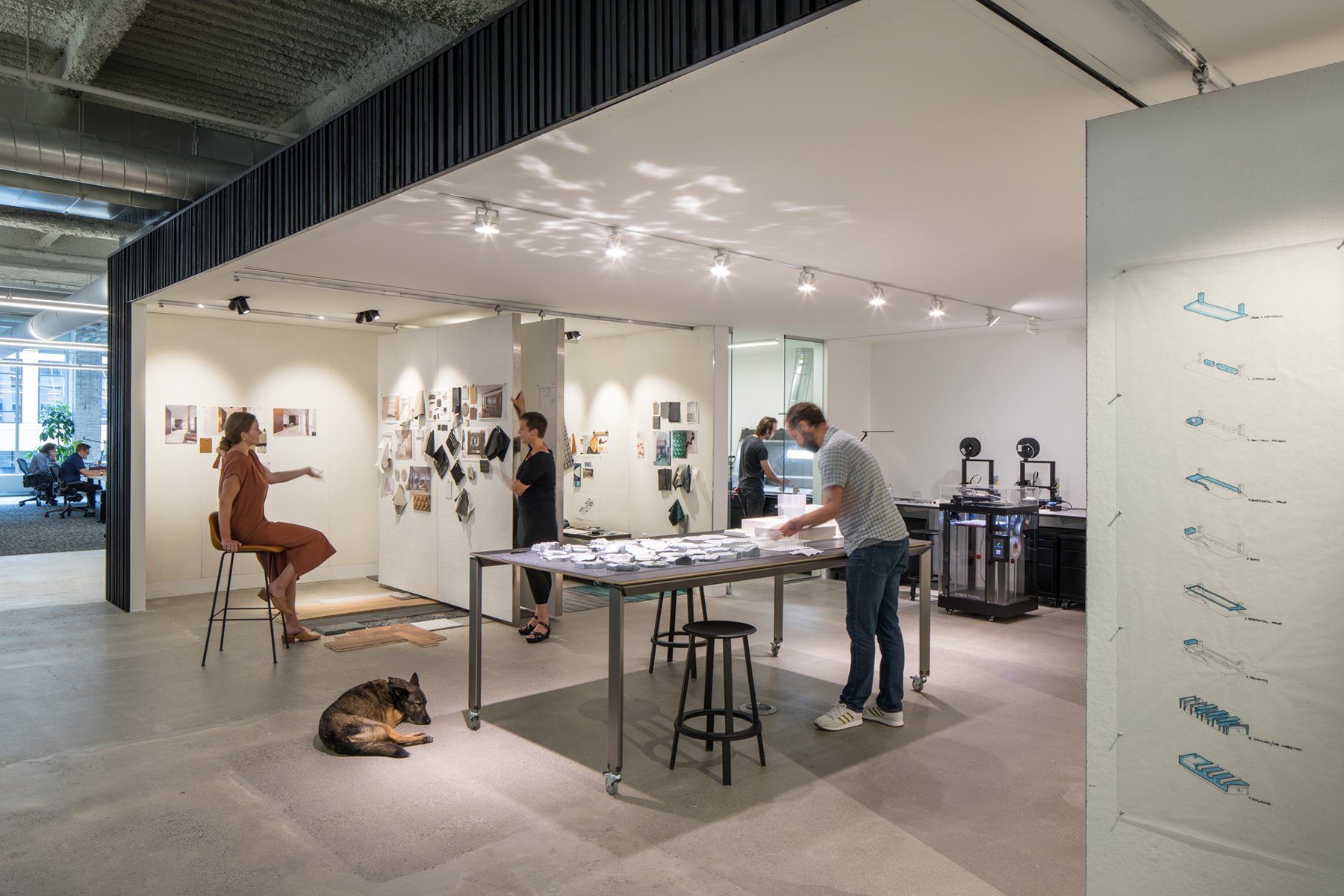Meeting the (Living Building) Challenge
The project teams for the first two commercial projects in Minnesota to receive Living Building Challenge certification share insights on what is required to achieve the highest sustainability standards in the building industry
By Justin R. Wolf | May 18, 2023
Wolf Ridge’s “2,000-acre classroom” includes the Margaret A. Cargill (MAC) Lodge, ski and hiking trails, campsites, wetlands, a solar panel array, and an organic farm, among other features. Photo by Chad Holder.
FEATURE
This feature appeared in the 2022 ENTER print annual, available for purchase here.
Green building certifications are many and varied. From LEED to BREEAM, Passive House to WELL, designers and builders across the globe utilize these programs to guide their efforts and spotlight the often hidden virtues of sustainable approaches. While all of these certifications help move the needle in addressing climate change, the International Living Future Institute’s (ILFI) Living Building Challenge (LBC), established in 2006, is extraordinarily rigorous and impactful. LBC focuses on regenerative design, and certification is based on actual, rather than modeled or anticipated, building performance.
Two Minnesota-based firms, HGA and MSR Design, have the rare distinction of having designed projects that have achieved LBC certification—the first two commercial projects in Minnesota to have done so. Only 30 projects worldwide have received full LBC certification, for meeting the requirements in all seven LBC categories, or petals. Another 43 have earned LBC Petal certification for achieving at least three petals. A total of 71 have been certified Net Zero or Zero Energy within the suite of ILFI programs, including two residences by SALA Architects in the Twin Cities.
“If the commitment isn’t there, you’re just not going to do it,” says MSR Design associate Simona Fischer, AIA. “Each LBC petal is all or nothing. You don’t get to pick and choose which items to pursue within a category.” MSR Design’s renovation of its downtown Minneapolis studio at 510 Marquette Avenue, completed in late 2019 with Stahl Construction, earned LBC Petal certification in the categories of Equity, Beauty, and Materials. (The other petals are Place, Water, Energy, and Health + Happiness.) “The motivation is to be a good steward,” says Stahl Construction senior project manager Deborah Aldrich. “[LBC] is LEED on steroids.”
Images 1–6: The 22,000-square-foot, 188-bed MAC Lodge is surrounded by a dense canopy of birch, maple, aspen, and conifers. Wolf Ridge executive director Peter Smerud describes the building’s LBC-certified design in this way: “Living buildings are about people.” All photos by Chad Holder.
HGA’s renovation of the Margaret A. Cargill (MAC) Lodge at Wolf Ridge Environmental Learning Center in Finland, Minnesota, with Gardner Builders, is the only renovation project in the world to achieve full LBC certification. “You’re digging into every possible detail of every building product. If even a single one falls through the cracks and lacks the proper documentation, the game is up,” says HGA sustainability director Ariane Laxo. Adds Gardner Builders CEO Bob Gardner: “It takes 12 months of [measuring building] performance to get certified. If your numbers slip in the last month, you have to start over again.”
The attention to minutiae required to achieve even a single petal, let alone all seven, can be daunting. When it comes to building materials, every link in the chain of custody must be accounted for. Every component in the lighting systems and plywood flooring, the mechanical fixtures and interior paints, must be free of materials on LBC’s Red List. To reach certification, every project stakeholder must be of the same mind and invested in an ethos of zero compromise.
“It’s a monumental task,” says Paul Kellner, owner of Heritage Window & Door, a key vendor on the Wolf Ridge project. Kellner says the biggest hurdle to success was sourcing materials that could pass muster. “When you have to ask a glass manufacturer where they’re buying their sand and what’s in it, and if they have a secondary source . . . well, you get hung up on a lot,” he explains. “There are probably 400 components in a window. All the chemicals in the caulks, the plastics, the glass and sealants and coatings—it all needs to be certified.”
When it comes to building materials, every link in the chain of custody must be accounted for. Every component in the lighting systems and plywood flooring, the mechanical fixtures and interior paints, must be free of materials on LBC’s Red List. To reach certification, every project stakeholder must be of the same mind and invested in an ethos of zero compromise.
Wolf Ridge executive director Peter Smerud is quick to praise the many vendors and subcontractors who went the extra mile to make the MAC Lodge a certified Living Building. For the 28 tons of local aspen that became 10,000 linear feet of siding, Smerud can trace the lumber’s full chain of custody with ease, from the logger who cut it to the trucker who hauled it and the plant manager who milled it. He fondly recalls how Heritage Window ensured that zero waste was generated in the delivery, unpacking, and installation of the lodge’s new windows and doors. And he lights up when he talks about paint.
As of 2017, no major manufacturer had a paint that met LBC’s high standard. Then one day Bob Ferrari, the regional rep for Benjamin Moore, and Chris Ellian, owner of Andren’s Paint Company in Duluth, showed up at Wolf Ridge, unsolicited. “Word had gotten out that we needed a compliant paint,” says Smerud. “They slid a Declare label across my desk” for Benjamin Moore’s Ultra Spec 500 line of interior paints, the first commercially sold paint to come with a Declare label. “Benjamin Moore didn’t do this because we were leveraging them to do it. They did it because someone said there’s a better way. They chose to step up.”
Ellian says Benjamin Moore took a calculated risk in transforming one of its top-selling products into a certified, one-of-a-kind paint. “Their approach was, ‘Let’s do this with the product that’s going to have the biggest impact and could effect the most change,’” says Ellian. “In an ideal world, where we’re not constrained by raw material shortages and shipping delays, we’re now better equipped to tackle some of these unorthodox projects, develop and deliver solutions, and retain the necessary knowledge that can be applied to future projects.”
Images 1–7: MSR Design used salvaged and reclaimed materials and worked with Stahl Construction to ensure that all waste was recycled or—if toxic and nonrecyclable—sequestered. All photos by Lara Swimmer.
A penchant for taking good risks and pushing past perceived limits is an attribute common to the HGA and MSR Design teams. MSR Design CEO Traci Lesneski, Assoc. AIA, says that closing the gap between the firm’s aspirations and the reality of achieving Petal certification “required a bit of a shift in mindset” on the part of MSR Design and its partners. “Experiencing the rigors of LBC as an owner helped us identify the challenges and opportunities within the program, which could then inform our other project work. We used our space as a testing lab.
For MSR Design, the decision to pursue LBC Petal certification over full certification came down to the context of the project. “We had hoped to pursue Health + Happiness, but a requirement of that petal is to install operable windows,” says Fischer. Since 510 Marquette overlooks a light-rail station and bus stop, operable windows would have been a questionable choice. “We have a very advanced filtration and exchange system. We did the biophilia element, and we prioritized daylight,” says Fischer. “We had to ask ourselves whether it was worth pursuing the extra petal if the reward was lower air and acoustic quality.”
Wolf Ridge’s remote North Shore location prompted a different set of considerations around certification. “Wolf Ridge is unique because its site and operations allowed us to maximize some of [LBC’s] imperatives that wouldn’t have been possible on another site,” says Laxo. LBC’s Ecology of Place, Access to Nature, and Education + Inspiration imperatives are core tenets of Wolf Ridge’s mission, and the institution has been incrementally moving toward self-sustainment for decades. “Everyone knew that if we didn’t achieve full certification, it would be because we couldn’t meet the Energy petal,” says Smerud. “And [not meeting the Energy petal] would come down to the fact that no combustion is allowed.” At least that used to be the case.
Wolf Ridge has its own district energy system that, according to HGA’s analysis, is carbon net positive. The system runs on a biofuel composed of 100-percent post-consumer waste wood fiber, which, technically speaking, is a form of combustion. Acknowledging the project’s challenging climate and site constraints, ILFI granted Wolf Ridge a special exemption for some of its energy needs, but not without requiring due diligence in related areas. The fiber is locally sourced from pallets that would otherwise go into landfills, the byproduct is shipped in bulk, and Wolf Ridge’s computer-automated boilers meet or exceed EPA guidelines for emissions.
Another especially tall hurdle for the Wolf Ridge team was sourcing all manner of lumber products that were both certified by the Forest Stewardship Council (FSC) and logged within 500 miles of the job site. “We’re in a region of the country where distance is measured in hours, not miles,” says Ellian
To meet these requirements, the student had to become the teacher—or at least a teacher’s assistant. When Smerud had difficulty locating FSC-certified trusses that were manufactured locally, he approached a supplier in Superior, Wisconsin, that had the ability to create a qualifying product. Similarly, MSR Design had a preferred millwork manufacturer, but the manufacturer lacked the necessary certification. In each case, the clients essentially helped train their respective vendors to establish a chain of custody and in the process assisted these companies in securing accreditation.
These kinds of stories—seasoned building professionals having to learn new best practices while coming to terms with the quantitative impacts of their decisions—are common among LBC projects. “It’s about being responsible, which is different than being sustainable. These are value-based decisions, not economically driven decisions,” says Certified Wood Products president Dan Haugen, whose company supplied Wolf Ridge with framing lumber, plywood, and OSB (oriented strand board) for the MAC Lodge.
The hope is that the economics of meeting LBC standards will become more enticing, or at least less of a deterrent. “Manufacturers talk to their accountants first, and they work their numbers backward,” says Kellner, who, like many of his peers, is enthusiastic but not blindly optimistic about the future of the program.
Laxo considers herself a realist. “There are untapped opportunities, and there are so many project types that could align really well with LBC principles—if everyone involved thinks holistically about design,” she says. “You just need buy-in from the owner, because right now it still costs more to do this.”
Laxo recommends using the AIA Framework for Design Excellence as a kind of gateway to the Living Building Challenge. “The Framework isn’t perfectly aligned with the Living Building Challenge, but there’s a ton of overlap,” she notes. The Framework expands the scope of the conversation, she says, “so questions of sustainability aren’t just focused on energy, water, and biophilia. The AIA is trying to inspire architects to think about all 10 Framework categories while designing, even if they’re not taking it to the level of LBC.”

